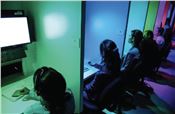Sensory Science Center hosts collaborative online conference with universities in Italy, Republic of Korea

A three-day online conference explored advances in "sensory nudging," a means of improving tradition taste-testing for food products.
(U of A System Division of Agriculture file photo by Fred Miller)
Brittaney Mann
FAYETTEVILLE, ARKANSAS
The Arkansas Agricultural Experiment Station’s Sensory Science Center hosted a three-day online conference, “Science-Telling About Revolution (STAR) in Sensory Nudges,” on October 19-21. Researchers and industry professionals from around the world joined the virtual event to share how sensory cues can alter perception and behavior towards food.
“Sensory nudging is characterized as leading consumers to experience foods or non-food products in a healthier, happier, more sustainable, or smarter way naturally through optimized sensory cues,” said Han-Seok Seo, director of the Sensory Science Center and a founder of the conference. “I call sensory nudges ‘sensory magics’ in that optimized sensory cues can invisibly encourage consumers into perceiving and behaving in a more positive direction.”
Seo said that many food industry professionals and food scientists are interested in how sensory cues affect consumer perception and liking of products. Items like tableware, food wrappers, lighting, background music and ambient scents impact how people choose, cook, consume and experience food and beverages.
Scholars from three institutions in North America, Europe and Asia organized the conference. The team included Seo, associate professor of food science for the experiment station, the research arm of the University of Arkansas System Division of Agriculture; Eleonora Carini, associate professor, and Maria Paciulli, assistant professor, both in the department of food and drug at the University of Parma in Parma, Italy; and Young-Gab Kim, professor in the department of computer and information security at Sejong University in Seoul, Republic of Korea.
More than 270 individuals from academia, research institutes, industry and the public applied to join the conference. Twenty-one speakers and session chairs presented at the conference, representing 15 institutions in seven countries including Denmark, Germany, Italy, Japan, Portugal, the Republic of Korea and the United States.
“The conference brought together the world’s best scientists in the field of consumer and sensory science,” Paciulli said. “It made it possible to point out the trending topics on these subjects and outline the future scenarios.”
Administrators of the three organizing institutions provided welcome remarks to start the event: Jean-François Meullenet, senior associate vice president for agriculture-research, director of the experiment station and interim dean of the Dale Bumpers College of Agricultural, Food and Life Science at the University of Arkansas; Daniele Del Rio, professor of human nutrition and president of the School of Advanced Studies on Food and Nutrition at the University of Parma; and Hyung-Seok Kim, dean of College of Software Convergence in Seoul.
The conference consisted of five sessions covering sustainability, food and sensory cues, consumers and sensory disorders, interdisciplinary solutions, and consumers and cognition, emotion and interface.
“This conference represented the first concrete and successful collaboration activity between the University of Parma and the University of Arkansas — hoping there will be other more and more stimulating collaborations,” Carini said.
The partnership with Sejong University also amplified the diversity of speakers and attendees, which improved the scientific discussion and conference value, Carini said.
Carini was the chair of the consumers and sensory disorders session.
The speakers discussed topics ranging from understanding the acceptance of edible insects in one’s diet, the preferences of Japanese consumers using questionnaire-based sociology and cognitive neuroscience, the impact of hearing loss on consumers’ texture perception and acceptance of solid and liquid food, emerging technologies in sensory and consumer science and considerations in product and consumer research.
Kim, the chair of the consumers and cognition, emotion and interface session, also noted the importance of collaborations in the sensory science field and the STAR conference.
"Topics in STAR in Sensory Nudges were various from academia to industry,” Kim said. “I think it encourages us to have greater ease in interdisciplinary collaboration. I expect more such collaborations to be established to enable us to grab new opportunities in the future."
Seo was the chair of the sustainability and foods and sensory cues sessions, and Paciulli was the chair of the interdisciplinary solutions session.
The conference ended with a flute performance by Cheyoung Lee, a student in the Department of Music at Sejong University and “8-Minute Pairing” online breakout rooms for attendees, organized by Ragita Pramudya, a Ph.D. candidate, and Seongjin Kim, a research assistant, at the Sensory Science Center.
Seo hopes that the attendees enjoyed learning the importance of sensory cues at the conference.
“It would have been challenging to organize this event without the support of the administrators at the three institutions. The organizing committee appreciates their great supports,” Seo said on behalf of the organizing committee.
“Last but not least, the organizing committee thanks the Sensory Science Center for hosting this conference and Dr. Jeyam Subbiah, department head and professor in the department of food science for the University of Arkansas System, for his support,” Seo said. ∆